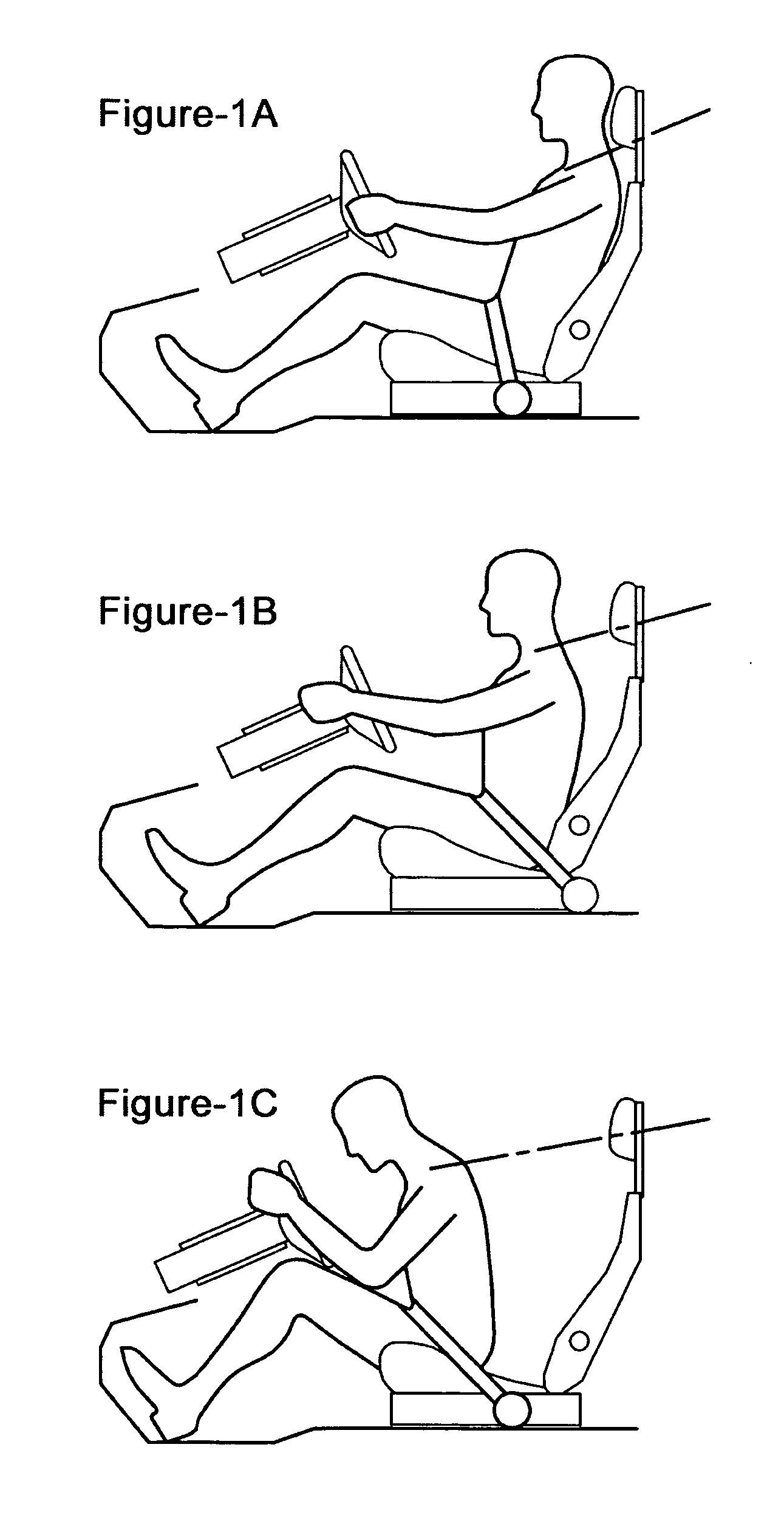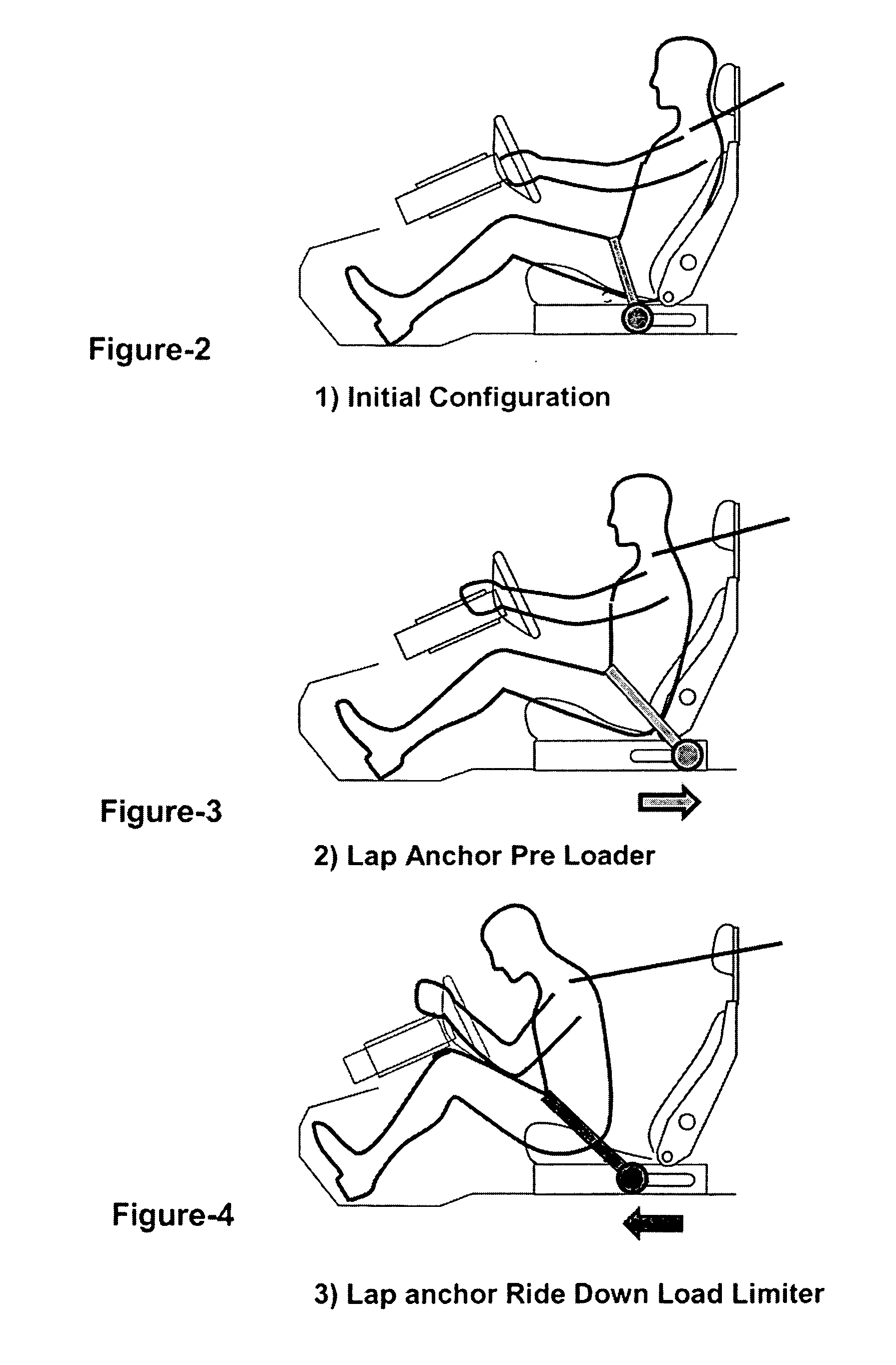Seat belt restraint and energy absorber
a seat belt and energy absorber technology, applied in the field of seat belt restraint and energy absorber, can solve the problems of excessive load acting on the body of the vehicle occupant, and achieve the effect of keeping the length of the belt constan
- Summary
- Abstract
- Description
- Claims
- Application Information
AI Technical Summary
Benefits of technology
Problems solved by technology
Method used
Image
Examples
first embodiment
[0040]FIGS. 1a to 1c illustrate the invention when used in a system having an initial comfort situation as depicted in FIG. 1a. The vehicle occupant restraint system is schematically shown when used by an occupant 1 being seated in a seat 2, in this case a driver's seat. The vehicle occupant restraint system comprises a belt 3, which extends from an effective belt guide 4 on each side of the seat 2. The belt emerges from the sides of the seat 2 at the effective side positions P. In FIGS. 1a-1c the belt 3 is a lap belt, which may advantageously be a part of a three-point belt having an additional shoulder portion 3′, being schematically depicted only.
[0041] In FIG. 1a, the belt is assuming a comfort configuration for normal driving situations. In the comfort configuration, the belt 3 is fastened about the occupant 1 and extends down to the effective side positions P at the side of the occupant's thigh, in a relatively vertical direction. This configuration is chosen because a positio...
fourth embodiment
[0071]FIG. 5c illustrates the subsequently following step where the belt is brought to a crash restraint configuration, e.g. the belt guide 4 is moved rearward. This configuration, as well as the set up for the ride down configuration including the load limiter device is similar to that described in relation to FIGS. 2a to 2c, and reference is made thereto for the function of this (See also FIG. 1b, 1c)
[0072]FIGS. 6a to 6c illustrate a fifth embodiment of an arrangement suitable for implementing the first embodiment of the invention, which is similar to the system of FIGS. 5a to 5c in that a pre-tension step is performed before the crash restraint configuration is attained. FIGS. 6a and 6b are intended to illustrated the pre-tensioning step only, which is why features relating to the altering between the crash restraint configuration and the ride down configuration are omitted from these figures and appear only in FIG. 6c.
[0073] The embodiment of FIGS. 6a to 6c differs from that o...
second embodiment
[0074]FIGS. 7a to 7c illustrate an arrangement suitable for the invention, wherein the belt guide 4 is rotationally displaced for accomplishing the displacement of the effective side positions P. The belt guide 4 is in this case associated to a first end of a rotational arm 19 whose other end is rotationally fixed at a centre 20. The belt guide is connected to the wire 7 continuing with the belt 3.
[0075]FIG. 7a shows the system in an initial comfort configuration. FIG. 7b shows the system in a crash restraint configuration in which the belt guide 4 has been moved rearwardly with respect to the comfort configuration by counter clockwise rotation of the arm 19. FIG. 7c shows the system in a ride down configuration, where the belt guide 4 has been moved forwardly with respect to the crash restraint configuration by further counter clockwise rotation of the arm 19. The function of this embodiment will essentially be the same of the first embodiment depicted in FIGS. 1a to 1c, although t...
PUM
 Login to View More
Login to View More Abstract
Description
Claims
Application Information
 Login to View More
Login to View More - R&D
- Intellectual Property
- Life Sciences
- Materials
- Tech Scout
- Unparalleled Data Quality
- Higher Quality Content
- 60% Fewer Hallucinations
Browse by: Latest US Patents, China's latest patents, Technical Efficacy Thesaurus, Application Domain, Technology Topic, Popular Technical Reports.
© 2025 PatSnap. All rights reserved.Legal|Privacy policy|Modern Slavery Act Transparency Statement|Sitemap|About US| Contact US: help@patsnap.com



